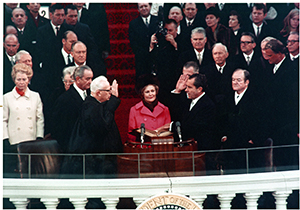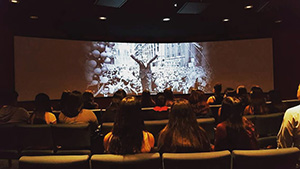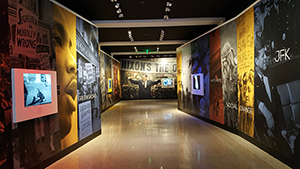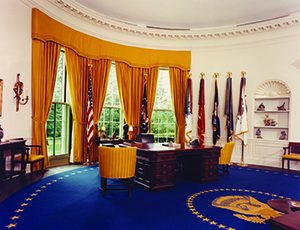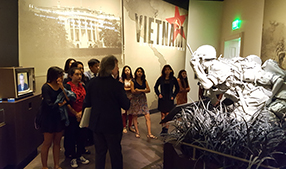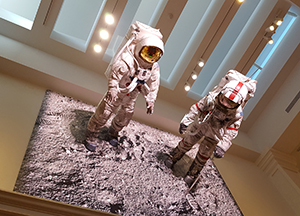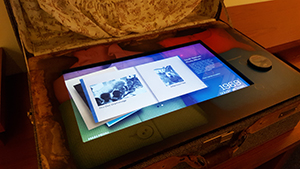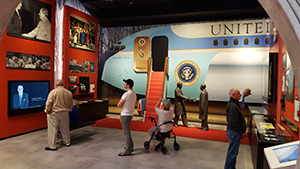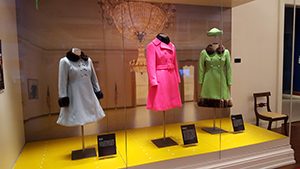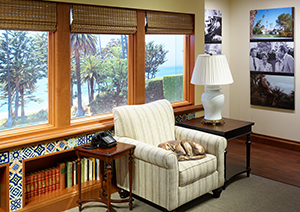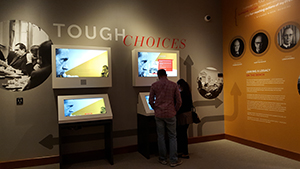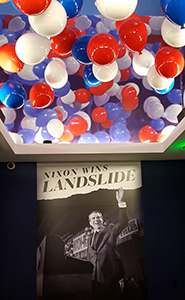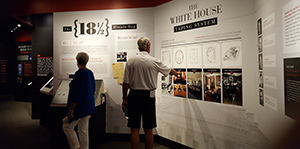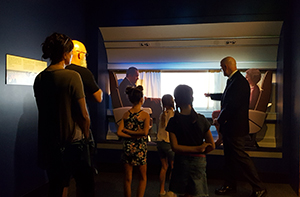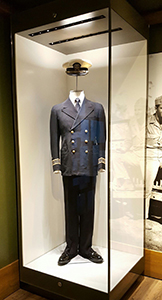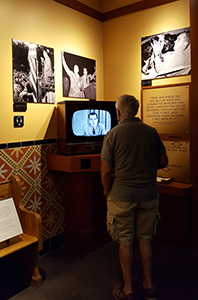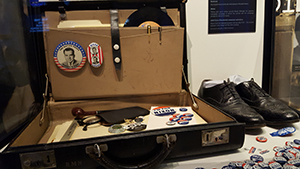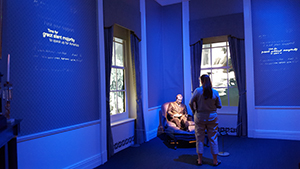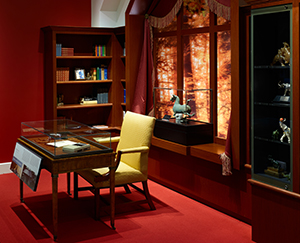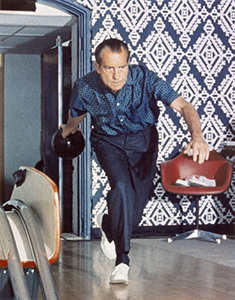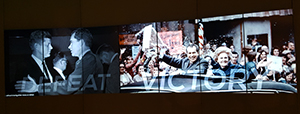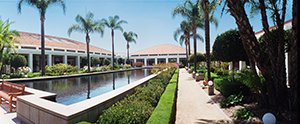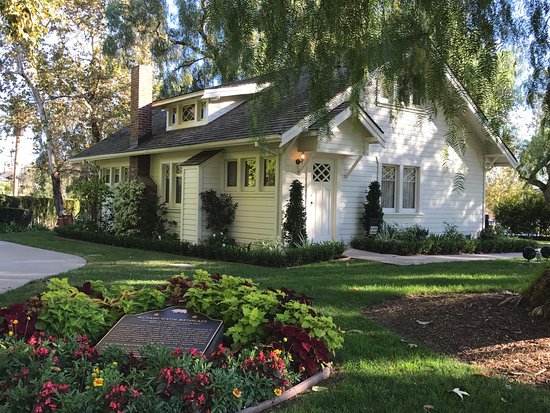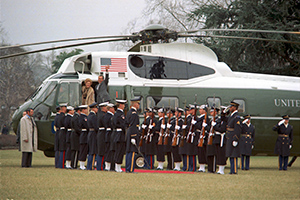The Permanent Galleries
The Museum features 22 unique spaces that incorporate multimedia and interactive technologies. Visitors begin their journey in the Malek Theater with a 13-minute orientation film before entering the permanent galleries in the “Wave of Change” gallery, which covers a period of great upheaval throughout the 1960s and during the months leading up to the November 1968 presidential election.
Travel through President Nixon's presidency and resignation and return to his origins in the “Back to the Beginning” gallery. From there, travel through Nixon’s life and his extraordinary accomplishments prior to becoming the 37th President of the United States.
The journey ends with Richard Nixon’s post-presidency period and his contributions as elder statesman, his impact on American culture, a solemn remembrance of Mr. and Mrs. Nixon’s memorial services, and the short “Epilogue” film at the conclusion of the exhibit.
-
Visitors begin their tour of the new museum by viewing a multi-media presentation that introduces Richard Nixon and his 50-year career in public service.
-
Vivid supergraphics stretch along curving walls as a barrage of sights and sounds brings to life some of the landmark events, people, and images of the years immediately preceding Richard Nixon’s election to the presidency. A "Nixon's the One" mural leads visitors through the election victory of 1968 into President Nixon's first term in office.
-
A replica of President Nixon’s Oval Office offers an immersive exploration of the most famous office in the world, including an opportunity to sit behind the president’s desk and take a photo or selfie.
-
Visitors are confronted with the situation in Vietnam, just as President Nixon was on January 20, 1969. Explore the contentious national conversation surrounding the Vietnam War and President Nixon’s actions and decisions.
Artifacts and vivid images highlight the stories of the POWs as well as their celebrated homecomings.
-
Discover the key ideas of President Nixon’s overall domestic policy, including empowering state and local governments, reorganization of the federal government, and fiscal responsibility.
• The focus on the environment, creation of the EPA and passage of the Clean Air and Clean Water acts. Guests might be surprised to discover the remarkable legacy of environmental preservation that can be traced to the Nixon presidency.
• The declaration of a "War on Cancer," and a collection of graphics, images, text, and artifacts invite guests to explore President Nixon's domestic policies in the field of healthcare.
• The relationship with the youth of America, in particular through legislation relating to Vietnam, the voting age, and the War on Drugs.
• Explore President Nixon’s role in desegregating southern schools and forwarding the cause of civil rights.
-
Explore the broader global issues of communism and the Cold War and their role in shaping President Nixon’s policy of détente.
A large section of the Berlin Wall is an iconic symbol of the split between the Communist and non-Communist worlds.
-
Step into a space that explores Pat Nixon as an influential First Lady and America’s Ambassador of Goodwill.
From her world travels to domestic initiatives, Pat Nixon shaped the ongoing progression of the role of the First Lady as an active, welcoming, and vital presence in the White House and throughout the world.
-
Stepping through an iconic moon gate portal, visitors relive the historic handshake between President Richard Nixon and Chinese Premier Zhou Enlai (Chou En-lai) during the February 1972 trip to the People’s Republic of China.
Images, text, and artifacts explore the relationship between the U.S. and China, Nixon’s China initiative, the diplomacy that culminated in the trip, the events of the Nixons’ time in China, and the legacy of the “week that changed the world.” Visitors can pose for a photo on the Great Wall of China with President and Mrs. Nixon.
-
An elegant space designed like a room in the White House highlights the First Family’s daily lives. An interactive experience invites guests to explore some of the events and entertaining that occurred in the Nixon White House, as well information on the Nixon family.
Cases display extraordinary state and public gifts, as well as a changing array of gowns and other clothing, from the museum collection.
-
A re-creation of President Nixon’s study at La Casa Pacifica immerses visitors in the life of the working Western White House in San Clemente, California.
-
Explore images, artifacts, and interactive technologies highlighting President Nixon's goals and achievements in the Middle East – most notably in regard to the Yom Kippur War – as well as how his policies in the region remain relevant today.
-
President Nixon’s landslide victory in the 1972 election is captured as a moment in time through the use of object from the museum collection and words from Richard Nixon’s second Inaugural Address.
-
The gallery helps visitors make sense of the web of personalities, actions, and intentions at the heart of the Watergate scandal as it chronicles the events beginning in June 1971 with the leak of the Pentagon Papers and the formation of a clandestine White House group known as "the Plumbers", and ending with former President Richard Nixon’s public explanations of Watergate after he left office.
The exhibition was originally created in 2011. Cosmetic updates integrate the exhibit into the design scheme of the new museum and technology upgrades enhance the visitor experience.
Explore the Evidence documented in the Watergate gallery.
-
Guests step inside Army One on August 9, 1974 with President and Mrs. Nixon as they depart the White House on the last day of the Nixon presidency. Media in the windows and an audioscape immerse guests in the departure and transition guests back to Richard Nixon's beginnings in Yorba Linda.
-
The view from the gallery windows offers a serene view of the humble farmhouse where Richard Nixon was born and spent his earliest years. A gallery of displays and photos tells the story of the future President's family, his childhood, the pivotal meeting with a young teacher named Pat Ryan, and his service in World War II.
-
The story of how Richard Nixon's early years prepared him for the many challenges that lay ahead is illustrated in galleries capturing some of the peak moments of the future President’s ambitious career, including his time in Congress, the Fund Crisis of 1952, and the Vice Presidency.
-
Visitors find themselves on a re-creation of the set for the Nixon/Kennedy televised debates - the first of their kind that would set the tone for decades to come.
-
President Nixon’s favorite room in the White House incorporates passages from his legendary yellow legal pad notes that he often penned in the intimate space.
-
In a realistic re-creation of Nixon's New Jersey study, visitors begin their exploration of Nixon's work as America’s Elder Statesman from 1974 to 1994.
-
From books to film, television, drama, opera, and more, Richard Nixon left a lasting mark on American culture. In this fun display, guests can explore both Nixon's own contributions through his 10 books and others' interpretations of the man and his legacy in popular culture.
-
A moving look at the deaths and funerals of both Richard and Pat Nixon including video excerpts of the former President's funeral attended by all of the living U.S. Presidents.
-
President Nixon’s own voice provides words of inspiration to send guests onward.
The museum also features:
● 70 new family-friendly exhibits with more than 300 original artifacts
● 30 unique multimedia experiences
● 11 original films
● 12 custom digital interactives
● 10 curated archival film sequences
● More than 600 photographs
● 8,000 square feet of wall murals
Beyond the Galleries
The Richard Nixon Presidential Library and Museum is also home to the gardens, the Birthplace of Richard Nixon, and the Presidential Helicopter.
-
The gardens are comprised of the Buzz Aldrin Moon Walk Plaza, California Formal Garden, Frank Nixon Citrus Grove, Oestricher Garden Glen, First Lady's Rose Garden, 1912 California Pepper Tree, Birthplace Garden, and the Pat Nixon Amphitheater. The gardens are also the final resting place of President Richard Nixon and First Lady Pat Nixon.
Guided tours are available on the weekends from the Nixon Library Docent Guild. LEARN MORE
-
Take a Google Arts and Culture 360-degree tour of Richard Nixon's Birthplace. Click HERE to explore.
President Nixon was born on January 9, 1913, in this house, which his father, Frank Nixon, built in 1912. Frank Nixon and his wife, Richard's mother Hannah, ran a citrus ranch on the surrounding land (now the site of the Nixon Presidential Library and Museum). The Nixon family lived in this house until 1922, when the ranch became unprofitable and they moved to Whittier, California.
The house then passed through a succession of owners. In around 1948, the Yorba Linda School District bought the structure, and it became a residence for the custodian of what later was named the Richard Nixon Elementary School, which was located next door until its demolition in 1988. In 1959, the school board and the citizens of Yorba Linda designated the house as a historic site. In 1990, it became a part of the private Richard Nixon Library and Birthplace, the antecedent of today's Federal Nixon Presidential Library.
The birthplace is open to visitors, who must be accompanied by a docent on their tour. Visitors will see artifacts that belonged to the Nixon family and other contemporaneous artifacts as they look through the 1.5-story building.
The birthplace may be closed due to inclement weather, including rain, wind, and excessive heat. Please contact us on the day of your visit to inquire of its status.
-
Please be aware: The helicopter may be closed due to inclement weather, including rain, wind, and excessive heat. Please contact us on the day of your visit to inquire of its status.
Watch a 2011 Tour of the Presidential Helicopter by C-SPAN. Click HERE.
One of the highlights of a trip to the Richard Nixon Presidential Library and Museum is the chance to step aboard Army One--the helicopter used by Presidents Kennedy, Johnson, Nixon, and Ford. Extensively restored and now on permanent display at the library, the helicopter presents visitors with a rare chance to see how presidents traveled aboard one of the most storied aircraft ever made.
The helicopter, which seats sixteen and cost a million dollars to construct in 1960, is a six-ton Sikorsky VH 3A "Sea King" model, bureau number 150617. During its presidential service, the helicopter was known either as Marine One or Army One, depending on whether Marine or Army pilots were operating the craft. President Nixon used it on more than 180 trips, including on overseas visits such as his summit meeting with President Anwar Sadat of Egypt in 1974.
Perhaps his most famous use of the helicopter was his last, on August 9, 1974. On that day, President Nixon resigned and flew in the helicopter from the South Lawn of the White House to Andrews Air Force Base, where he boarded Air Force One for a flight to his private residence in San Clemente, California.
The helicopter was retired from White House service in 1976 and later used for the training of Secret Service. After being put in storage, the helicopter's interior and exterior were restored, and it was installed on the grounds of the library in 2006. The helicopter was refurbished in conjunction with the 2016 redesign of the permanent museum galleries.
The Sikorsky VH 3A "Sea King" helicopter is on loan courtesy of the National Museum of the Marine Corps.
The helicopter may be closed due to inclement weather, including rain, wind, and excessive heat. Please contact us on the day of your visit to inquire of its status.
Virtual Museum Tours
Looking for information about hours, admission, or directions? Click HERE
Looking for information about current and upcoming exhibitions? Click HERE
Watch the Richard Nixon Foundation's "A Look Inside the Nixon Library"
MORE VIRTUAL TOURS:
2016 Tour of the newly reopened museum by CBS Sunday Morning. Click HERE.
Take a Google Arts and Culture 360-degree tour of Richard Nixon's Birthplace. Click HERE to explore.
2019 Walking tour of the Richard Nixon Presidential Library and Museum galleries and gardens by Walking Tours Video. Click HERE.
2020 President's Day walking tour includes educational displays, America's government, the presidential classroom, and the Apollo exhibit by KCW Plus. Click HERE.


